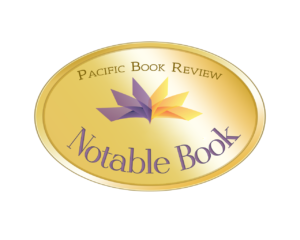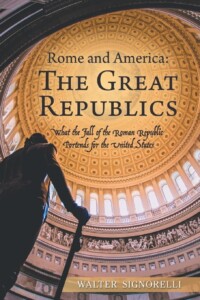Title: Rome and America: The Great Republics: What the Fall of the Roman Empire Portends For The United States
Author: Walter Signorelli
Publisher: Ewings Publishing LLC
ISBN: 979-8894191126
Pages: 572
Genre: Non-Fiction / Politics & Social Science
Reviewed by: Anthony Avina
Pacific Book Review
 Throughout human history, there have been many powerful civilizations and kingdoms which have added knowledge and a better understanding of civilization to the world. One of the most prolific and prominent of the ancient world was none other than the Roman Empire, a vast world superpower which has become synonymous with famed architecture, the arts, military superpower, and so much more. Since the fall of Rome, many world leaders, government powers, and monarchs have risen and fallen in its wake, but in our modern world, few would argue the closest world leader to come close to that of the Roman Empire is none other than the United States.
Throughout human history, there have been many powerful civilizations and kingdoms which have added knowledge and a better understanding of civilization to the world. One of the most prolific and prominent of the ancient world was none other than the Roman Empire, a vast world superpower which has become synonymous with famed architecture, the arts, military superpower, and so much more. Since the fall of Rome, many world leaders, government powers, and monarchs have risen and fallen in its wake, but in our modern world, few would argue the closest world leader to come close to that of the Roman Empire is none other than the United States.
The many similarities and few differences between Rome and the United States become the central discussion points in author Walter Signorelli’s Rome and America: The Great Republics: What the Fall of the Roman Empire Portends For The United States. The book focuses on the many ways in which both the Roman Empire and the United States share common ground, from the way the founding fathers became inspired by Roman mottos, architecture and government foundations, to the shocking paths the United States could find itself on if it doesn’t learn from the mistakes of Rome and change its ways before the United States falters and destroys itself – much like the Roman Empire did, all the way through the 2024 events in the United States political system.
A truly thorough and well researched book, the author does a remarkable job of finding a natural balance between examinations of Roman and American history, and the ways in which they intersect. The detail the author provides, from Jefferson being influenced by Roman architecture enough to design government buildings in a similar fashion, to taking on similar iconography for military branches which were also featured in Roman military structures, and even more in depth analysis such as the divide between Burr and Hamilton and the use of Caesar as an insult amongst the divided government parties at the founding of the United States. Not only does the author explore the beginnings of both Rome and America, but the long and storied history of both as well, and the way the author was able to compare military strategies such as the U.S. struggles in the Middle East to Rome’s struggles with the King of Pontus was mind-blowing.
Anyone with an interest in history, both ancient and current, as well as political sciences and government functionality, will be thoroughly invested in this book, especially those who love any history involving ancient Rome and the United States as a whole. The level of detail the author provides and the multitude of different aspects of both Roman and American rule that the author explores provide a descriptive, thoughtful look into the two most powerful empires the world has ever seen. The foundation for democracy, the perils of failing to learn from the past, and the ways in which in-fighting and failing to address the needs of the people versus personal political and monetary gain all come to the forefront in this memorable and insightful book.


